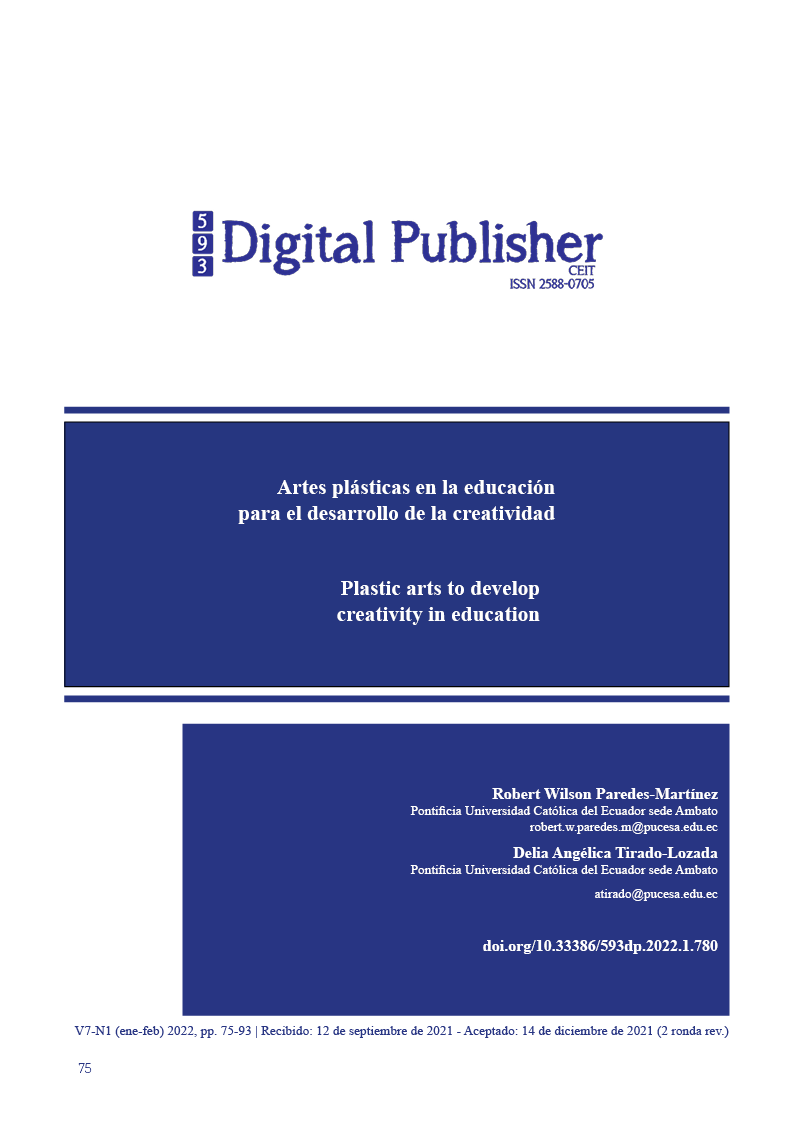Plastic arts to develop creativity in education
Main Article Content
Abstract
Pedagogically, developing certain skills in plastic arts can actually contribute towards creativity in teenagers within the General Unified Baccalaureate. This work aims to determine the influence of plastic arts in education, considering that drawing is important to develop creativity by introducing certain stages using a creative thinking test.
This research methodological approach is descriptive and correlational. A survey was conducted to measure creativity under the study population. They were examined before and after the test to demonstrate that plastics arts are essential to develop creativity.
The findings show that the learning process in artistic education could contribute to creativity in education, improving cognitive and motor skills, concentration, memory and attention.
Downloads
Article Details

This work is licensed under a Creative Commons Attribution-NonCommercial-ShareAlike 4.0 International License.
1. Derechos de autor
Las obras que se publican en 593 Digital Publisher CEIT están sujetas a los siguientes términos:
1.1. 593 Digital Publisher CEIT, conserva los derechos patrimoniales (copyright) de las obras publicadas, favorece y permite la reutilización de las mismas bajo la licencia Licencia Creative Commons 4.0 de Reconocimiento-NoComercial-CompartirIgual 4.0, por lo cual se pueden copiar, usar, difundir, transmitir y exponer públicamente, siempre que:
1.1.a. Se cite la autoría y fuente original de su publicación (revista, editorial, URL).
1.1.b. No se usen para fines comerciales u onerosos.
1.1.c. Se mencione la existencia y especificaciones de esta licencia de uso.
References
Eslava Albarracín, D. G. (2002). EL DIBUJO COMO HERRAMIENTA PARA LA EDUCACIÓN EN SALUD. Revista Eletrônica de Enfermagem (online), 19.
Esquivias Serrano, M. T. (2004). CREATIVIDAD: DEFINICIONES, ANTECEDENTES Y APORTACIONES. Revista Digital Universitaria, 17.
Zambrano U, H. M. (2016). LA INVESTIGACIÓN EN EL ARTE –LA RELACIÓN. Dialnet, 7.
Alcaide, C. (2003). Expresión plástica y visual para educadores. Madrid: ICCE .
Arjona, J. B., Illera, R. M., & Sanz, C. C. (2012). Las Industrias Culturales y Creativas. Dialnet, 124.
Arratia Toribio , Z. (2015). El desarrollo de la creatividad a través del dibujo en la Educación Infantil. Universidad de Valladolid, 54.
Artola, T., Sánchez, N., Barraca, J., Ancillo, I., Mosteiro, P., & Poveda, B. (2011). Cambios en el pensamiento divergente a lo largo del ciclo vital. ¿Son los niños y adolecentes mas creativos que los adultos? Researchgate, 16.
Benitéz, M. Á. (2010). EL ARTE EN LAS DIFERENTES ETAPAS HISTÓRICAS. APORTACIONES ESTÉTICAS. PROPUESTAS EDUCATIVAS PARA DESARROLLO DEL ARTE EN LA MATERIA DE DIBUJO. . Sevilla: WANCEULEN EDITORIAL, S.L. .
Bottinelli, K., Kyeong, Y., & Cheung, C. ( 2018). Adolescents’ Drawing and Divergent Thinking: Does Culture Matter? Journal of Educational and Developmental Psychology; Vol. 8, No. 2; 2018, 12.
Cárdenas, R., & Troncoso, A. (2014). Importancia de las artes visuales en la educación: Un desafío para la formación docente. Revista Electrónica Educare (Educare Electronic Journal), 191-202.
Cárdenas-Pérez, R. E. (2014). Importancia de las artes visuales en la educación:. Revista Electrónica Educare, 12.
Conejo, I. M. (2019). INTERRELACIONES ENTRE LA CREATIVIDAD, EL ARTE, LA EDUCACIÓN Y LA TERAPIA. . Arte y Movimiento, 12.
Duarte, R. (2011). Industria cultural 2.0. Dialnet, 28.
García Morales, C. (2012). ¿QUÉ PUEDE APORTAR EL ARTE A LA EDUCACIÓN? EL ARTE COMO ESTRATEGIA PARA UNA EDUCACIÓN INCLUSIVA. Arte y Sociedad, 12.
Granados Conejo, I. M. (2009). Interrelaciones entre la creatividad, el arte, la educación y la terapia . Arte y Movimiento, 51-62.
Guilford, J. P. (1991). Joy Paul Guilford (1897 - 1987). Revista Latinoamericana de Psicología., vol. 23, núm. 1, pp. 125-127.
Gutíerrez Cabrera , A. (2008). El Dibujo como estrategia para el fomento de la creatividad en el aula. Universidad Pedagógica Nacional, 94.
Horkheimer, M., & Adorno, T. (1994). Dialéctica de la Ilustración, fragmentos filosóficos. Madrid: Trotta S. A.
López; Veledo, González. (2014). La motivación en el área de Expresión Plástica. Arte Individuo y Sociedad, 16.
Nuñez, A. P. (2016). La creatividad más allá del genio creador. Revista Arte y Diseño A&D, 48-56.
Núñez, A. P. (2016). La creatividad más allá del genio creador. Arte & Diseño, 9.
Oliveira, E., lmeida, L., Ferrándiz, C., Ferrando, M., Sainz, M., & Prieto, M. D. (2009). Tests de pensamiento creativo de Torrance (TTCT):elementos para la validez de constructo en adolescentes portugueses. REAALYC, 7.
Pérez, M. (2015). Las Artes Plástica como Eje Transversal en la Educación Artística. Revista escenarios, 135.
Rinaudo, M. C. ( 2002,). Reseña de "Creatividad. El fluir y la psicología del descubrimiento y la invención." de Mihaly Csikszentmihalyi. RED. Revista de Educación a Distancia, 9.
Rodríguez y Romero. (2001). La creatividad en collage: su validación social. Venezuela: Escuela de Psicología, Universidad Central de Venezuela.
Tárrega, Pellicer. (2014). La educación plástica y visual en espacios de arte. Universitat Jaume, 20.



